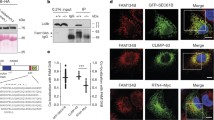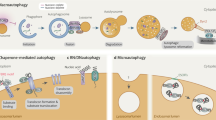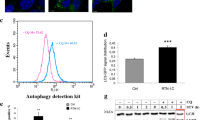Abstract
Adaptation to changing physiological conditions requires continuous adjustment of endoplasmic reticulum (ER) capacity. Cells have evolved elegant mechanisms to enlarge and shrink their ER according to need. An ER-localized monitoring system senses insufficient protein folding capacity and activates ER biogenesis to expand the organelle. Furthermore, cells dispose of excess or damaged ER by selective autophagy (ER-phagy). Together, these mechanisms ensure ER homeostasis and proper cell function.
Similar content being viewed by others
Literatur
Wiest DL, Burkhardt JK, Hester S et al. (1990) Membrane biogenesis during B cell differentiation: most endoplasmic reticulum proteins are expressed coordinately. J Cell Biol 110:1501–1511
Bolender RP, Weibel ER (1973) A morphometric study of the removal of phenobarbital-induced membranes from hepatocytes after cessation of treatment. J Cell Biol 56:746–761
Walter P, Ron D (2011) The unfolded protein response: from stress pathway to homeostatic regulation. Science 334:1081–1086
Schuck S, Prinz WA, Thorn KS et al. (2009) Membrane expansion alleviates endoplasmic reticulum stress independently of the unfolded protein response. J Cell Biol 187:525–536
Mochida K, Oikawa Y, Kimura Y et al. (2015) Receptormediated selective autophagy degrades the endoplasmic reticulum and the nucleus. Nature 522:359–362
Schuck S, Gallagher CM, Walter P (2014) ER-phagy mediates selective degradation of the endoplasmic reticulum independently of the core autophagy machinery. J Cell Sci 127:4078–4088
Khaminets A, Heinrich T, Mari M et al. (2015) Regulation of endoplasmic reticulum turnover by selective autophagy. Nature 522:354–358
Fumagalli F, Noack J, Bergmann TJ et al. (2016) Translocon component Sec62 acts in the endoplasmic reticulum turnover during stress recovery. Nat Cell Biol 18:1173–1184
Schuck S (2016) On keeping the right ER size. Nat Cell Biol 18:1118–1119
Author information
Authors and Affiliations
Corresponding author
Additional information
Jasmin Schäfer 2005–2008 Ausbildung zur Biologielaborantin. 2008–2014 Biochemiestudium in Frankfurt am Main. Seit 2014 Doktorarbeit am Zentrum für Molekulare Biologie der Universität Heidelberg (ZMBH) im Labor von Dr. S. Schuck.
Sebastian Schuck 1995–2000 Biochemiestudium in Hannover und Tübingen. 2001–2006 Doktorarbeit am Max-Planck-Institut für molekulare Zellbiologie und Genetik, Dresden, im Labor von Prof. Dr. K. Simons. 2006–2013 Postdoktorand an der University of California, San Francisco, im Labor von Prof. Dr. P. Walter. Seit 2013 Gruppenleiter am Zentrum für Molekulare Biologie der Universität Heidelberg (ZMBH).
Rights and permissions
About this article
Cite this article
Schäfer, J.A., Schuck, S. Biogenese und Autophagie des Endoplasmatischen Retikulums. Biospektrum 23, 762–764 (2017). https://doi.org/10.1007/s12268-017-0868-3
Published:
Issue Date:
DOI: https://doi.org/10.1007/s12268-017-0868-3




